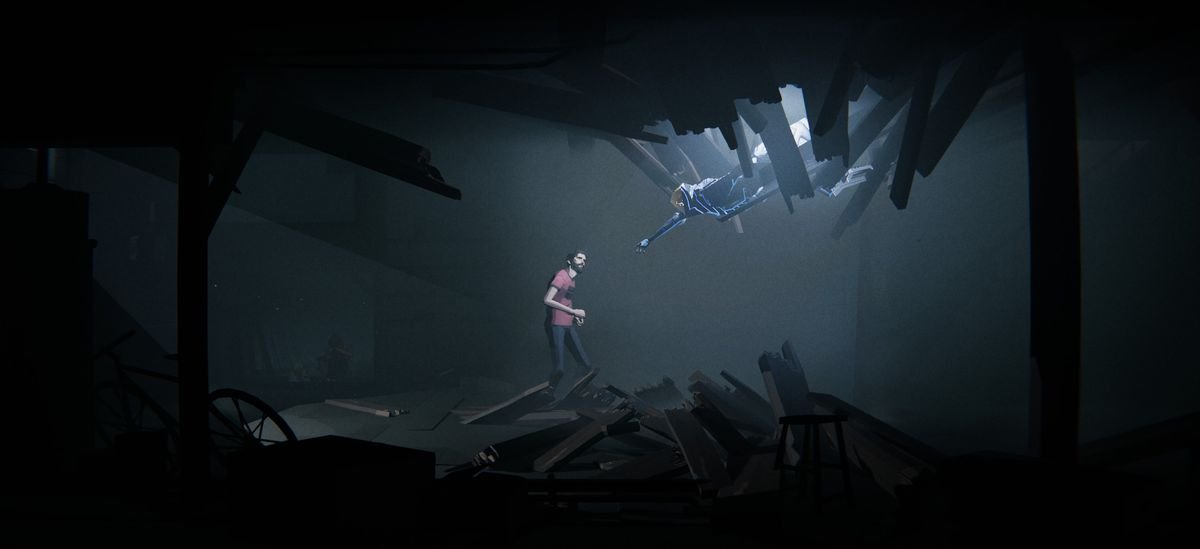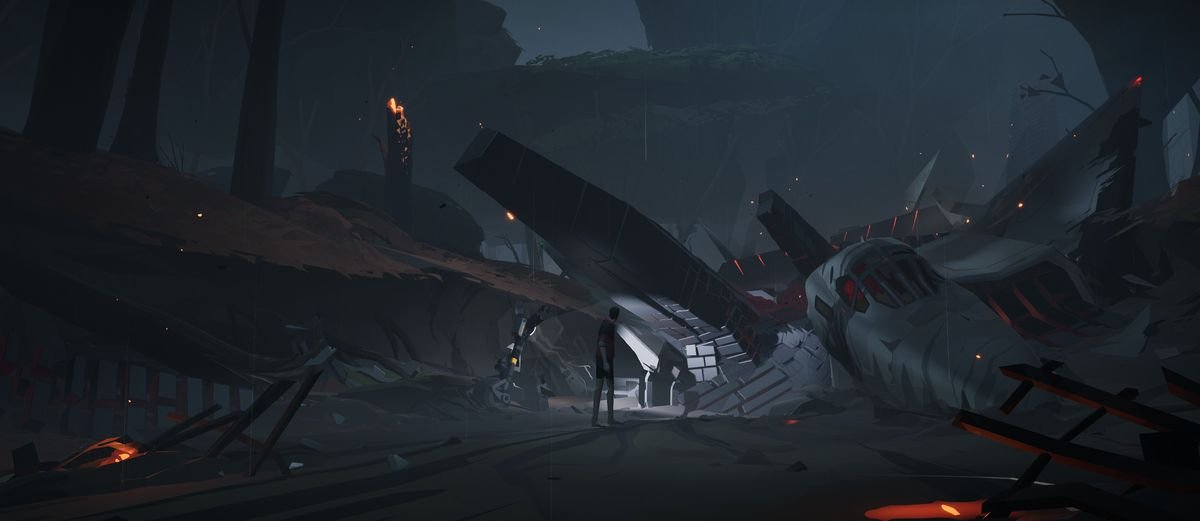The first thing you should know about Somerville, the spiritual sequel to Limbo and Inside, is that the story makes sense. Its predecessors lived on the far end of the narrative spectrum, somewhere between “Buñuelian nightmare” and “that time you smoked salvia in college and disassociated while reading Orwell.” But Somerville, well, it’s a bit normal. At first.
The Somerville elevator pitch needs only one floor: “What if someone finally made War of the Worlds into a decent video game?” Because H.G. Wells’ novel (and its countless variants) has achieved that rarefied level of pop culture ubiquity, the early beats will be familiar: a bit of domestic bliss interrupted by an apocalyptic alien invasion; Earth’s collapse from the POV of the folks on the ground; the distant possibility of a counter-maneuver to gird humanity from total annihilation.
This time, rather than follow the president or the world’s sexiest scientist, we get a guy who just wants to see his wife and kid again. The guy has no knack for violence, and no talent for survival beyond a slightly elevated ability to problem-solve on the fly. He’s like a particularly clever and/or lucky ant skittering to stay alive during a family picnic.
Of all War of the Worlds adaptations, Somerville has most in common with Steven Spielberg’s Tom Cruise vehicle, released a few years after the 9/11 attacks. Cars zip erratically along a highway, fleeing in a direction where things are probably just as bad — maybe worse. Survivors hide in sewer drains or gather at impromptu evac centers. An outdoor festival is abandoned, as if its partygoers had been raptured.

Image: Jumpship via Polygon
Because this is a video game, our guy gets to hike into the night with a superhuman power. In the moments after the invasion, but before the family gets yanked apart, the dad has a close encounter with an alien soldier. With a tap of fingers and a period of unconsciousness, he receives the gift to transmogrify light into a world-bending tool.
When he touches a desk lamp or a ceiling fan or a spotlight, he can channel blue energy through the current, converting the natural white light into a seafoam glow that melts alien materials into a sort-of-living goop. Not much later, he acquires a red energy that, with a concussive pulse, solidifies the alien goop, like lava instantly hardening into rock. Most of Somerville’s puzzles involve the dissolving and restoring of materials, liquefying stones to fill a gap with melted other-world sludge, then hardening its surface so that the guy and his dog can hobble across the crust.
And so the dad sets out on a journey across a world that looks a bit like our own, but moodier and utterly demolished. In this way, the game looks and plays an awful lot like the games of Playdead. You walk left or right across a more or less 2D space, solving puzzles, hiding from unstoppable enemies, and piecing together a story performed with pantomime rather than dialogue.

Image: Jumpship via Polygon
But this isn’t a Playdead game. Following the release of Inside, Playdead co-founder and executive producer Dino Patti left the studio and founded Jumpship, where he hired new talent. Somerville’s director and writer, Chris Olsen, came from the world of animation, and from that, he brings a more acute interest in the cinematic — not just in blockbuster set-pieces, but the little things, too: the wide shot and the close-up.
So while the game presents at first blush as another Limbo or Inside, as its journey continues, the similarities chafe off like a snake shedding its skin.
What do I mean by that? Basically, the game works best when it’s not being much of a game at all. When the guy leaves his demolished home, he leans on the door frame and cranes his neck, looking for his dog. When he evades the spotlights of a behemoth alien ship, the camera pulls back until he’s a spot on the screen. You can tell that an animator had greater-than-usual control, because every character and creature and catastrophe has been granted so much time and care. We’ve seen this level of detail — in which characters engage with the world and the people around them — in mega-budget projects like The Last of Us Part 2, but rarely in a game this size, where prioritizing animation means deprioritizing something else.

Image: Jumpship via Polygon
Speaking of: As the adventure finds its footing, its creators seem to lose interest in puzzles altogether — for the better, frankly. The puzzles are fine, fussy, and a bit forgettable. In the back half, our guy’s journey skews closer to the walking simulators of the 2010s, where the only real obligation is to keep moving forward. This too comes with some minor irritation, as the game’s dark visuals and the character’s diminutive size can lead to confusion about how to interact with the world. Occasionally, I understood where the game wanted me to go, but couldn’t immediately grasp how it expected me to, say, climb a rock or swim across a pond. Most bothersome were the handful of instant-death action sequences that broke the flow entirely, forcing me to retry three or four times.
These flaws held back Inside and Limbo, and it’s disappointing to see them now span three games over 12 years, presumably following creative talent from one studio to another.
To counter myself, the problems may just be inevitable side effects of this style of game. And the solution may fall as much on the player (read: me) as the designer. For example, how I play this sort of platforming adventure game has changed over the years. They’re narratively static, built like movies, moving from scene to scene in precisely the same manner every time. So now, I treat them like movies for me to perform. The first playthrough serves as script notation and dress rehearsal, allowing me to work out the kinks and the catches. The second playthrough is where the game becomes itself, so to speak, as I act out the journey with perfected pacing. I hit my marks, and in return, the game plays like the spectacle it was always meant to be.

Image: Jumpship via Polygon
I wonder if Somerville expects most players to have a similar experience — hitting credits and starting all over, this time with less interest in puzzles, and more interest in the cinematic. The game’s short run time (only a few hours) and the possibility of alternate endings (we’ll leave that to Reddit and YouTube to unpack) suggest as much.
For the second playthrough, I switched from Steam Deck to a large TV. I’m glad I did, because while this game doesn’t necessarily look like a AAA game, it feels like one. So play on the largest screen with the best headphones or speakers you can find.
Somerville is a delightful, delectable bite to conclude a year that will be remembered for multicourse meals. We could leave it at that, I suppose. But I’d like to pull back, one last time, to the game’s pedigree. Because beyond being an entertaining video game, Somerville carries an unusual amount of game industry significance — or baggage, depending on your angle of approach.

Image: Jumpship via Polygon
In 2010, Danish studio Playdead released Limbo, one of the first indie games to benefit from internet-connected consoles and digital storefronts. A small team could reach a huge audience without appearing on the shelf at Walmart — and without all the associated overhead costs. Inside appeared six years later in the thick of the “indiepocalypse,” when those same online stores had become overcrowded with dozens of new releases each week. Its predecessor guaranteed attention from reviewers, and its quality earned high marks, elevating the dystopian yarn above its thousands of contemporaries. Now, another six years later, we have a conclusion of sorts in Somerville, a project that shows how indie games have become not-so-indie, that established talent has the money and the cachet to break apart and do separate things. What’s more, Jumpship has partnered with Microsoft to make Somerville available at launch on Game Pass, drawing a direct line backward to Limbo’s original appearance on Xbox Live Arcade. The upstarts have become the elders.
Of course, Inside developer Playdead still exists. In 2020, the studio announced a partnership with game publisher and storefront Epic Games. When that deal bears fruit, we may see the official conclusion to this historic indie game trilogy. With Somerville in the world as an interim conclusion, of sorts, it’s safe to expect that both the original plant and its cutting will be just fine, branching in their own moody and lovely ways.
I have kept one thing from you, and that’s the final act. Limbo, and especially Inside, understood that a memorable ending makes for a memorable game. Somerville retains this lesson, and for all its familiarity and narrative clarity, the game loosens its grip on the wheel until suddenly it’s careening off-road into… something you will have to experience for yourself.
Perhaps, then, Somerville is the most welcoming of the three games, starting with the familiar, and riding the slow, exponential line upward into the bizarre. Wise choice. For all the craft required to make a clear, playable movie, nothing beats the otherworldly weirdness of video games.
Somerville will be released on Nov. 15 on Windows PC, Xbox One, and Xbox Series X via Game Pass. The game was reviewed on PC using a pre-release download code provided by Jumpship. Vox Media has affiliate partnerships. These do not influence editorial content, though Vox Media may earn commissions for products purchased via affiliate links. You can find additional information about Polygon’s ethics policy here.























































